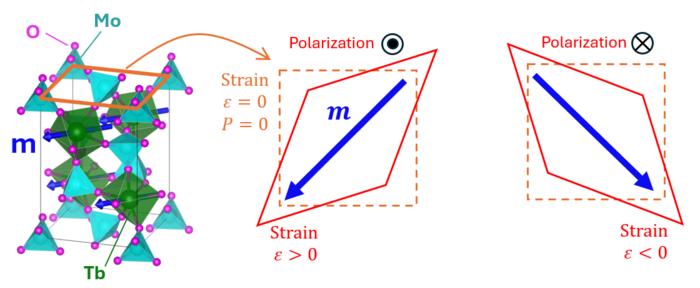
Researchers at Tohoku University have recently made a groundbreaking discovery in the realm of multiferroic materials, specifically focusing on terbium oxide, Tb2(MoO4)3. This material demonstrates remarkable multiferroic properties, allowing it to maintain its functionality even at elevated temperatures of up to 160 °C. This achievement is particularly significant because the operational temperature limit for most multiferroics has traditionally hovered around room temperature. As such, this discovery offers new avenues for practical applications in various advanced technologies, including spintronics and memory devices.
Multiferroics are materials that exhibit a unique combination of magnetic and electric properties. This dual functionality is crucial, as it allows for energy-efficient devices that leverage the strengths of both magnetism and ferroelectricity. The limitations of current multiferroic materials arise from their inability to function effectively at higher temperatures – a major barrier to their practical use. Most materials in this category could not withstand heat generated by surrounding environments or operational demands, thus curbing their applicability in real-world scenarios.
The research team at Tohoku University conducted extensive investigations to explore the potential of Tb2(MoO4)3 as a high-temperature multiferroic. Their findings demonstrated that this material displayed hallmark characteristics typical of multiferroics, including the ability to manipulate electric polarization through the application of a magnetic field. The ability to induce such changes at temperatures reaching 160 °C represents a significant leap from the previously recorded threshold of around 20 °C. This development heralds a new era for the potential applications of multiferroics, particularly in industries that demand high operational temperatures.
The scientists attribute this innovative capability to the synergistic interplay between two effects present in the material: the piezoelectric effect and the magnetoelastic effect. The piezoelectric effect refers to the material’s capacity to generate electric polarization in response to mechanical strain, a feature that is essential for many technological applications. Meanwhile, the magnetoelastic effect involves the coupling between magnetic properties and mechanical strain, allowing for values of magnetization to be manipulated through applied physical forces.
Through careful experimentation, the researchers successfully combined these two effects, activating the coupling between electric polarization and magnetization, known as the magnetoelectric effect. This new understanding of the relationships between various physical properties at high temperatures opens up exciting possibilities for creating more efficient energy and information technologies.
According to Shimon Tajima, one of the lead researchers in this study, “This work may pave new avenues for exploring high-temperature multiferroics.” This statement captures the essence of their findings, advocating the notion that heightened temperature stability could expand the range of applications for multiferroic materials considerably. The prospect of realizing energy-saving spintronics devices and advanced optical devices with greater functionality than ever before demonstrates the significant impact of their work.
In addition to its promise for governmental and industrial applications, this advancement also raises important questions about the fundamental properties of multiferroics themselves. Understanding how Tb2(MoO4)3 retains its crossover behavior at intensified temperatures invites deeper investigation into the atomic-level interactions that govern these properties. Future theoretical and experimental work may uncover additional materials with similar or even superior characteristics, thereby fueling further innovation.
The researchers published their groundbreaking findings in the prestigious journal, Communications Materials, which is known for its commitment to disseminating high-quality research in the field of materials science. This publication serves as a testament to the importance of their work and ensures that the scientific community is aware of the potential applications derived from high-temperature multiferroics.
Consequently, the implications of this work extend beyond mere academic curiosity; they suggest a pathway toward developing novel technologies that leverage the unique properties of multiferroic materials. Managing energy consumption has become paramount in the modern world, and materials like Tb2(MoO4)3 could significantly contribute to creating devices that are not only more efficient but also generate less waste heat.
As research continues to forge ahead in understanding multiferroic systems, it is critical to consider the environmental impact and sustainability of these new technologies. Greater efficiency translates to reduced energy requirements, which in turn can decrease dependence on fossil fuels. Such an outcome is significantly aligned with global initiatives for carbon neutrality and sustainability in the face of climate change.
In summary, the impressive capabilities of Tb2(MoO4)3 underscore the importance of interdisciplinary approaches to solving complex challenges in materials science and engineering. By marrying fundamental scientific inquiry with practical application, this research paves the way for a future where advanced technologies could become both environmentally sustainable and energy-efficient.
As we look to the horizon, innovations such as these are crucial for addressing the demands of a rapidly evolving technological landscape. The team at Tohoku University has thus not only advanced the field of multiferroics but has also set an inspiring precedent for future breakthroughs in science and technology.
Subject of Research: Multiferroic properties of Tb2(MoO4)3 at high temperatures
Article Title: A high-temperature multiferroic Tb2(MoO4)3
News Publication Date: 18-Dec-2024
Web References: Link to DOI
References: Communications Materials, DOI: 10.1038/s43246-024-00717-8
Image Credits: ©Shimon Tajima
Keywords
Magnetic fields, Spintronics, Magnetization, Materials science, Physics, Electromagnetism
Tags: Energy-efficient devicesferroelectricity and magnetismhigh-temperature multiferroicsinnovations in memory devicesmultiferroic materials researchovercoming limitations of multiferroicspractical applications of multiferroicsspintronics applicationsTb2(MoO4)3 advancementstemperature resistance in materialsterbium oxide propertiesTohoku University research findings





